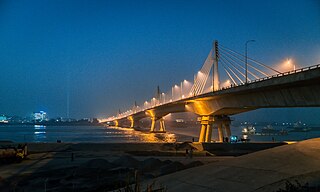
Chittagong, officially Chattogram, is the second-largest city in Bangladesh. Home to the Port of Chittagong, it is the busiest port in Bangladesh and the Bay of Bengal. It is the administrative seat of an eponymous division and district. The city is located on the banks of the Karnaphuli River between the Chittagong Hill Tracts and the Bay of Bengal. The Greater Chittagong Area had a population of more than 5.2 million in 2022. In 2020, the city area had a population of more than 3.9 million. The city is home to many large local businesses and plays an important role in the Bangladeshi economy.

Education in Bangladesh is administered by the country's Ministry of Education. The Ministry of Primary and Mass Education implements policies for primary education and state-funded schools at a local level. Education in Bangladesh is compulsory for all citizens until the end of grade eight. Primary and Secondary education is funded by the state and free of charge in public schools.

Government Hazi Mohammad Mohsin College is one of the renowned colleges of Bangladesh located in Chittagong, Bangladesh. Named after Muhammad Mohsin, a 19th-century philanthropist, it is one of the oldest educational institutions in the country, originally established in British India in 1874 as the Chittagong Madrasha. It offers Higher Secondary Certificate (HSC) in the national curriculum of Bangladesh coupled with bachelor's degree and master's degree in various disciplines in association with National University, Bangladesh.
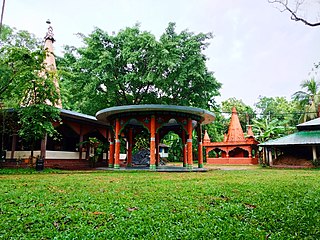
Chandanaish is an upazila of Chattogram District in Chattogram Division, Bangladesh.

Lohagara is an upazila of Chattogram District in Chattogram Division, Bangladesh. Lohagara is situated between Chattogram and Cox's Bazar. It is one of the largest and most densely populated upazilas of Bangladesh. It has headquarters in Lohagara.

Kabi Nazrul Government College (KNGC) is a governmental college located in Luxmibazar, Dhaka, the capital of Bangladesh. It was formerly known as Govt. Kabi Nazrul College.
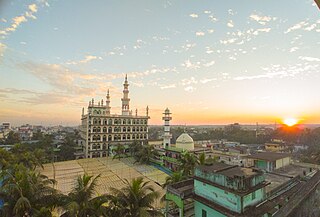
Al-Jāmiʿah al-Ahliyyah Dār al-ʿUlūm Muʿīn al-Islām, popularly known as the Hāṭhazārī Madrasah or the Great Madrasah, is a Qawmi institution of Hathazari, located in Bangladesh's Chittagong District. Established in 1901, it is the largest and oldest Deobandi seminary in the country. According to a 2009 National Bureau of Asian Research report, the highly reputed institution ranks among top ten madrasah in the subcontinent.

Al-Jāmiʿah Al-Islāmiyyah Patiya, better known simply as Patiya Madrasa and formerly known as Al-Madrasah Aḍ-Ḍamīriyyah Qāsim al-ʿUlūm, is a Qawmi Madrasah located in Patiya Upazila of Chittagong District, Bangladesh. It was established in 1938 by Azizul Haq under the direction of Zamiruddin Ahmad. It is also known as an International Islamic University. It has a role in the promotion of Islam in Bangladesh, inclusion of Qawmi Madrasas under one syllabus, providing modern and higher education for scholars.
Qawmi Madrasah is an adjective describing one of the two major madrasah educational categories in Bangladesh. The Qawmi madrasahs are not regulated by the Bangladesh Madrasah Education Board. As private charitable organizations, Qawmi madrasahs are supported almost exclusively by donation.

Abdur Rahman Chatgami, also known as Faqihul Millat, was a Bangladeshi Islamic scholar of the Deobandi school. He was born in Imam Nagar, Fatikchhari, Chittagong, in 1920. He was the founder director of the Islamic Research Center Bangladesh, Dhaka.
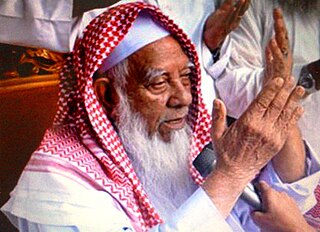
Shah Ahmad Shafi was a Bangladeshi Sunni Islamic scholar, the chief of Hefazat-e-Islam Bangladesh, Rector of Al-Jamiatul Ahlia Darul Ulum Moinul Islam Hathazari and also the chairman of Bangladesh Qawmi Madrasah Education Board. He was born in 1930 in Rangunia, Chittagong and was educated at Hathazari Madrasah and Darul Uloom Deoband.
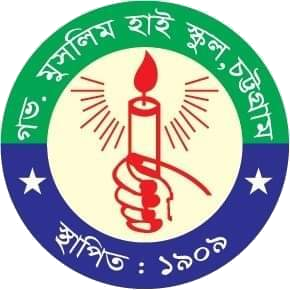
Government Muslim High School is a public secondary boys-only school in the court hill area of Kotwali Thana, Chittagong, Bangladesh. It was established in 1874 as the Chittagong Madrasah and was separated in 1909. The school's enrollment is currently 2,501 students.
Pomra is a village of Rangunia Upazila at Chittagong District in the Division of Chittagong, Bangladesh.
Abū al-Khayr Muḥammad Ayyūb ʿAlī al-Māturīdī, or simply Ayub Ali, was a Bangladeshi Islamic scholar, author and educationist. He was awarded the Ekushey Padak in 1976 by the Government of Bangladesh.

The Government agencies in Bangladesh are state controlled organizations that act independently to carry out the policies of the Government of Bangladesh. The Government Ministries are relatively small and merely policy-making organizations, allowed to control agencies by policy decisions. Some of the work of the government is carried out through state enterprises or limited companies.
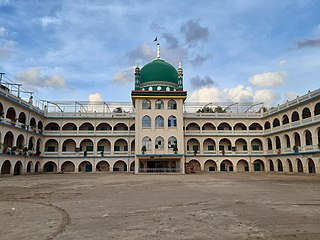
Jamia Ahmadiyya Sunnia Kamil Madrasah (Arabic: الجامعة الأحمدية السنية الكاملية; Bengali: জামেয়া আহমদিয়া সুন্নিয়া কামিল মাদরাসা)), popularly known as the Jamia Ahmadiyya is prominent higher educational institution in Sholashahar, Chandgaon, Chittagong, Bangladesh. Established in 1954, it is one of the largest and oldest Sunni Barelvi Madrasah in Bangladesh. Renowned Islamic scholar, Syed Ahmad Shah Sirikoti was its founder. It was established on the basis of doctrine of Imam Ahmed Raza Khan. Syed Muhammad Tayyab Shah was the patron of the institution. Now Syed Muhammad Taher Shah and Syed Muhammad Sabir Shah are patron of the institution.
Barakhain Jameya Jamhuria Fazil Madrasah is an Islamic institution situated at Barakhain in Anwara, Chittagong. It was established to train the students Islam-based education and culture in 1974.
Baitush Sharaf Adarsha Kamil Madrasah ) is a religious educational institution and alia madrasah in Bangladesh. The madrasah was founded in 1982 by Shah Sufi Abdul Jabbar. The madrasah is located in Dhanialapara area under Double Mooring Thana of Chittagong city. This madrasah secured the first rank in the departmental level in the Dakhil examination held under Madrasa Education Board in 2019.

Hazi Mohammad Mohsin Government High School is a public secondary school, located in Chittagong, Bangladesh. It was founded in 1874 as a muslim religious school. In 1979, it was named after the philanthropist Muhammad Mohsin.

Haji Muhammad Mohsin Government High School or formerly known as Rajshahi Government Madrasha is a secondary school located in Rajshahi in Bangladesh. It was founded by the Mohsin Endowment in 1874. During its establishment, this institution was established as a Madrasa. Later it was converted into a secondary school. In 2019, it was renamed after Muhammad Mohsin.















